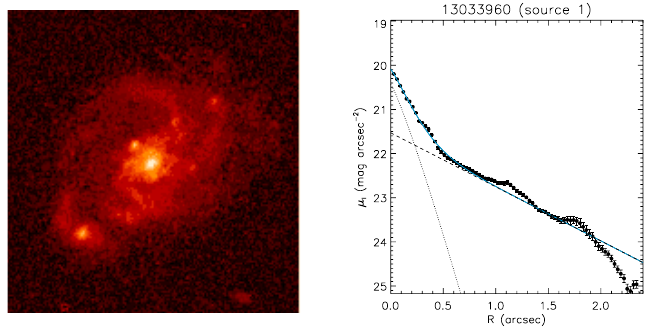Coordenação:
José Afonso
Âmbito:
Understanding the formation and evolution of galaxies is one of the comerstones of modem cosmology. Over the last few years observations have provided important clues on how galaxies must have evolved in the Universe, and theoretical models have been struggling to keep pace in an epoch of successive observational breakthroughs, as better and deeper datasets become available. The “classical” Cold Dark Matter structure formation models from the 1990s predicted that galaxies form purely hierarchically, big galaxies assembling via successive mergers of smaller ones [1, 2]. This would lead to the assembly of large baryonic masses only at z<1. however observations reveal that at least some massive m>10^11 M_sun) galaxies are already in place by z~2 [3, 4], and their stars appear to be the oldest at their respective epochs (e.g., [5]). Also, the theory was notably unable to predict the observed star formation history of the Universe, overpredicting the number of star-forming galaxies at the bright end of the luminosity function. This lead to the idea of “downsizing”, where increasingly massive galaxies form at increasing redshifts. “Downsizing” has been implemented in recent galaxy evolution models using various prescriptions, but most often via AGN and star formation feedback mechanisms [6,7].
Although the current theories appear promising as a way of explaining the formation a and evolution of galaxies, there is one element that is notably absent from the entire picture. Galaxies without a bulge are not well understood – one might argue, not understood at all – in the framework of Lambda Cold Dark Matter (CDM) cosmology: they are simply too difficult to produce in a merger dominated Universe. Galaxy disks, thought to be formed naturally out of gas infall into dark matter halos [8], are easily disturbed and even destroyed by interactions with even low-mass halos [10]. The disk-dominated and bulgeless galaxies produced by the simulations are smaller, denser, and have lower angular momentum than observed (also known as the angular momentum problem for bulgeless galaxies). Feedback mechanisms can improve the simulations, but insufficiently [11].
Our current lack of understanding the physics in bulgeless galaxies is also obvious when considering the observed tight correlation between supermassive black hole (SBH) masses and host galaxy bulge properties (its stellar velocity dispersion, mass, and luminosity; e.g., [12 – 15]). Currently unexplained, this correlation leaves little doubt that the formation and evolution of galaxy bulges is linked to the formation and evolution of BHs. Consequently, bulgeless galaxies should not be able to host an Active Galactic Nuclei (AGN). And yet, several observations of AGN in bulgeless galaxies currently indicate that a classical bulge is not a requirement for a nuclear black hole [16-19]. How to conjugate these observations with the BH – bulge correlation is still unknown.
Recognizing the significance of bulgeless galaxies, several groups have recently started to perform systematic studies of such objects in the nearby Universe. In particular we note the use of the Sloan Digital Sky Survey (SDSS) to establish a benchmark for the local Universe [20) and the significance of AGN feedback in bulgeless galaxies, including quenching of star formation [21; also co-Is Lobo and Anton are leading an extension of such worl< with the support of the EURO-VO AIDA Research Initiative 2008].
In this study we aim to take the research to the next level. Using the best and most extensive datasets available to probe the intermediate and distant Universe, we propose to perform the first systematic study of bulgeless galaxies at intermediate redshifts (z~0.5). With some of the deepest and more detailed observations at any wavelength ever performed, and with the expertise to analyze and interpret those data, we will be able to perform a study of z~0.5 bulgeless galaxies with comparable detail to the SDSS studies of bulgeless galaxies in the local Universe. This will allow us to determine the significance of bulgeless galaxies and bulgeless AGN when the Universe was less than two-thirds of its current age (5 Gyr in the past), an epoch much more active than currently. Considered together with the nearby Universe studies, this will allow us to start understanding the evolutionary path of bulgeless systems within the overall galaxy formation and evolution scheme.
Institutions & Research Units involved in the project:
– Fundação da Faculdade de Ciências (FFC/FC/UL)
– Associação para o Desenvolvimento da Faculdade de Ciências (ADFC/FC/UP)
– Centro de Astrofísica da Universidade do Porto (CAUP/UP)
– Centro de Astronomia e Astrofísica (CAA/FC/UL)
– Centro de Investigação em Ciências Geo-Espaciais (CICG/FC/UP)
– Faculdade de Ciências da Universidade de Lisboa (FC/UL)

